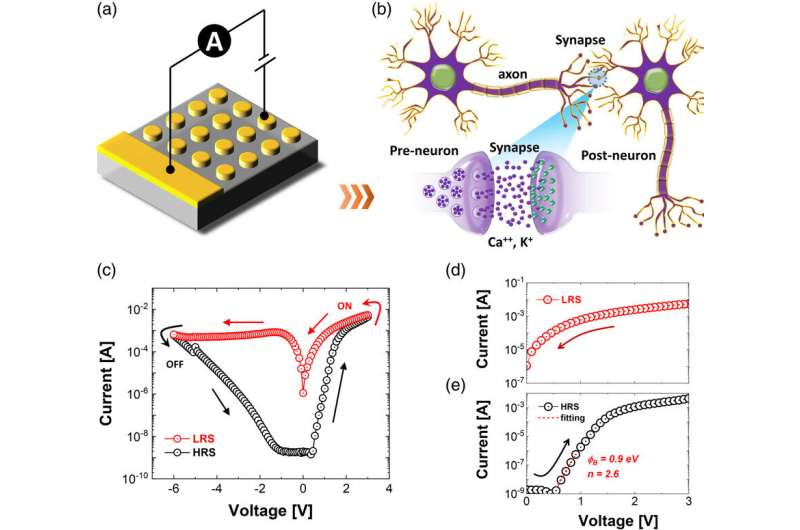Scientists design artificial synapses for neuromorphic computing

The human brain has been called the most complicated object in the universe. Trying to replicate that still-unmatched capability for computing, scientists at Los Alamos National Laboratory have made a new interface-type memristive device, which their results suggest can be used to build artificial synapses for next-generation neuromorphic computing.
Memristive devices, or memristors, represent long-sought circuit technology that, unlike current resistor technology, has both programming and memory capabilities—memristors could remember which electrical state they were in when powered off, a human brain-like ability that opens up new possibilities for computing and devices.
“Data processing is an essential part of today’s science, with machine learning, artificial intelligence and artificial neural networks used to address pressing questions in everything from climate science to national security applications,” said Aiping Chen, Laboratory scientist with the Center for Integrated Nanotechnologies.
“But conventional computing architecture demands a great deal of energy and is increasingly less able to scale up to meet bigger and bigger data challenges. Neuromorphic computing, which mimics the unmatched data storage and processing architecture and capabilities of the human brain, offers a path to continue to extend computing performance.”
Conventional computing is constrained by the so-called von Neumann bottleneck, in which computing and memory are separate. Processing advanced tasks like machine learning and image recognition on digital computers consume a significant amount of energy and time due to transferring the data back and forth between a central processing unit and memory. Data center energy consumption has increased rapidly in the past few years, with projections that approximately 8% of the world’s electricity will be used by data centers by 2030.
Additionally, in conventional computer architecture, billions of transistors on silicon-based microchips serve as switches for a computer’s binary code. Physical limits to the miniaturization of those transistors have helped spell the end of Moore’s Law, a maxim that foretold the doubling of processing power roughly every two years.
In-memory computing: Just like a brain
Co-locating information storage and processing at synapses, which connect the 100 billion neurons sending and receiving chemical information, the human brain’s “in-memory processing” saves time and energy. Neuromorphic computing relies on emergent devices such as memristors, switches between two terminals that control and remember the charge flowing through, to replicate the structure and function of synapses.
In the fast-evolving field of neuromorphic computing, memristor designs have included filament systems, in which a charge is delivered through the devices. But, prone to overheating, filament systems lack stability and reliability.
Chen and his colleagues are working on a different approach called an interface-type memristor, and have produced a reliable, high-performing device with a simple structure based on an Au/Nb-doped SrTiO3 interface—essentially gold and other semiconducting materials.
The interface-type memristors can, in principle, be scaled down to nanometer size that even filament-based memristor technology cannot achieve. (By contrast, a human hair is approximately 100,000 nanometers thick.) And especially in contrast to transistor-based neuromorphic chips, the interface-type memristive device needs significantly less power to fuel its processing.
“Different from digital computing with a von Neumann architecture, neuromorphic computing, inspired by biological systems, works just like a brain,” said Chen. “The advantages of that structure include low-energy consumption, high parallelism and excellent error tolerance. The human brain runs at only 20 watts, after all, but learns extremely effectively. These advantages make it very good for advanced computing tasks like learning, recognition and decision-making.”
Excelling at advanced computing tasks
The team used artificial neural-network simulation to study the computing performance of the interface-type memristor, testing it against a dataset of handwritten images from the Modified National Standards and Technology database maintained by the National Institute of Standards and Technology. Demonstrating excellent uniformity, programmability and reliability, the device realized a recognition accuracy of 94.72%.
That performance makes the team believe these new interface-type memristive devices can be a fundamental hardware piece for next-generation neuromorphic computing.
“The capabilities we’re seeing suggest that neuromorphic chips, like human brains, will be good at advanced tasks that include learning and real-time decision-making,” said Chen. “We could see neuromorphic computing enable a lot of applications that require intelligence, from self-driving cars, to drones, to security cameras. Basically, many things that people are capable of doing, these types of devices will be able to do.”
The team plans to continue to develop the technology with an emphasis on the need for co-design—hardware design informed by algorithmic approaches offered by computer scientists.
More information:
Sundar Kunwar et al, An Interface‐Type Memristive Device for Artificial Synapse and Neuromorphic Computing, Advanced Intelligent Systems (2023). DOI: 10.1002/aisy.202300035
Citation:
Scientists design artificial synapses for neuromorphic computing (2023, June 1)
retrieved 1 June 2023
from https://techxplore.com/news/2023-06-scientists-artificial-synapses-neuromorphic.html
This document is subject to copyright. Apart from any fair dealing for the purpose of private study or research, no
part may be reproduced without the written permission. The content is provided for information purposes only.
For all the latest Technology News Click Here
For the latest news and updates, follow us on Google News.

